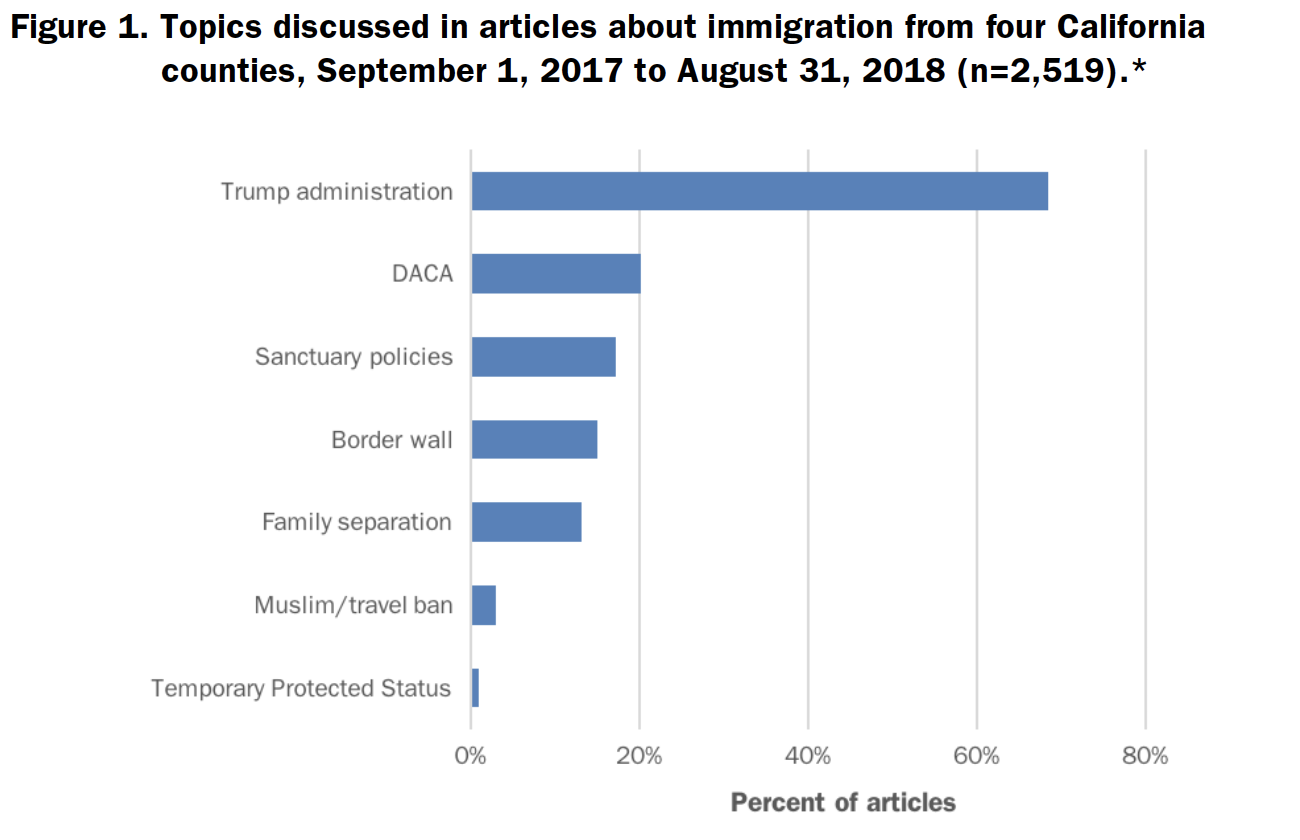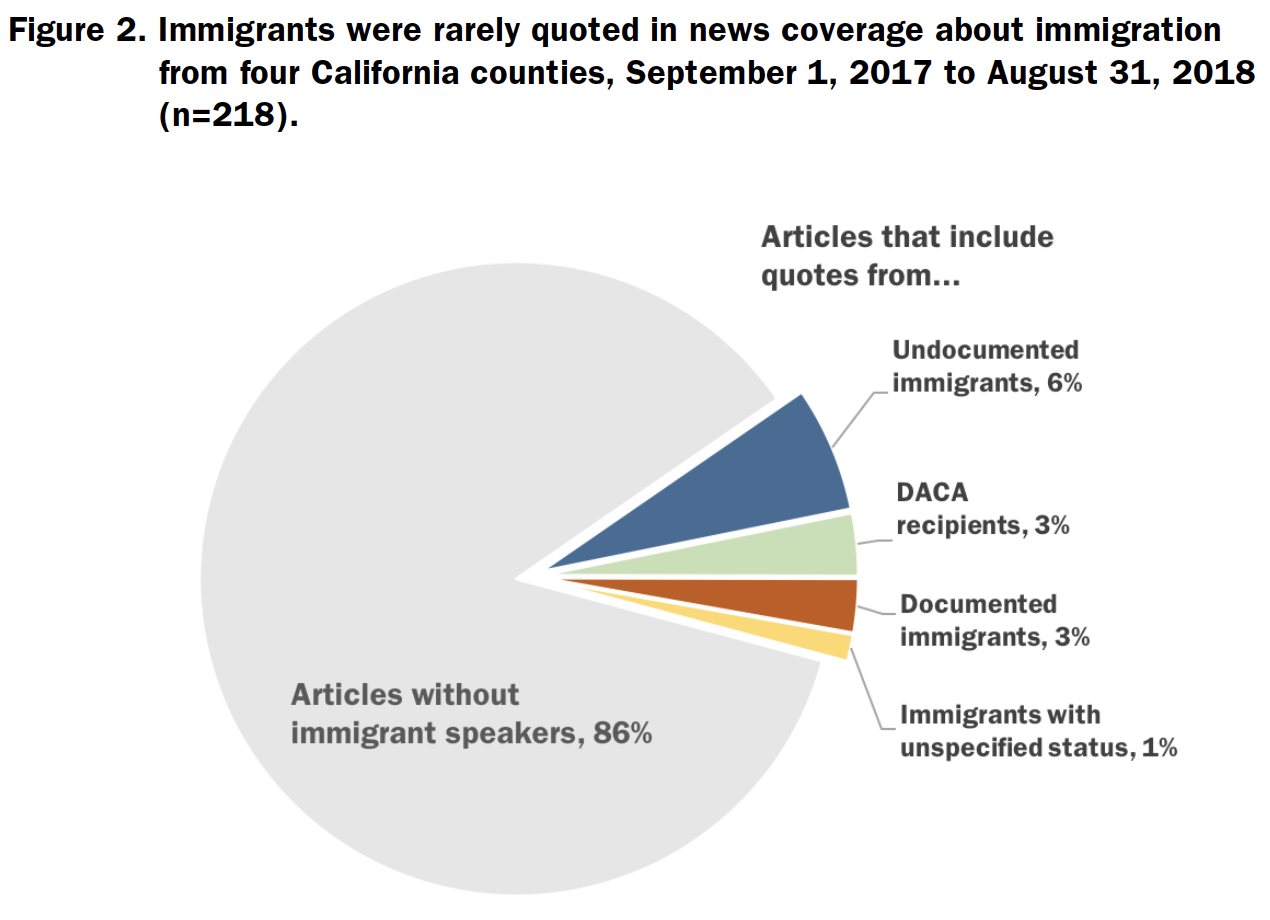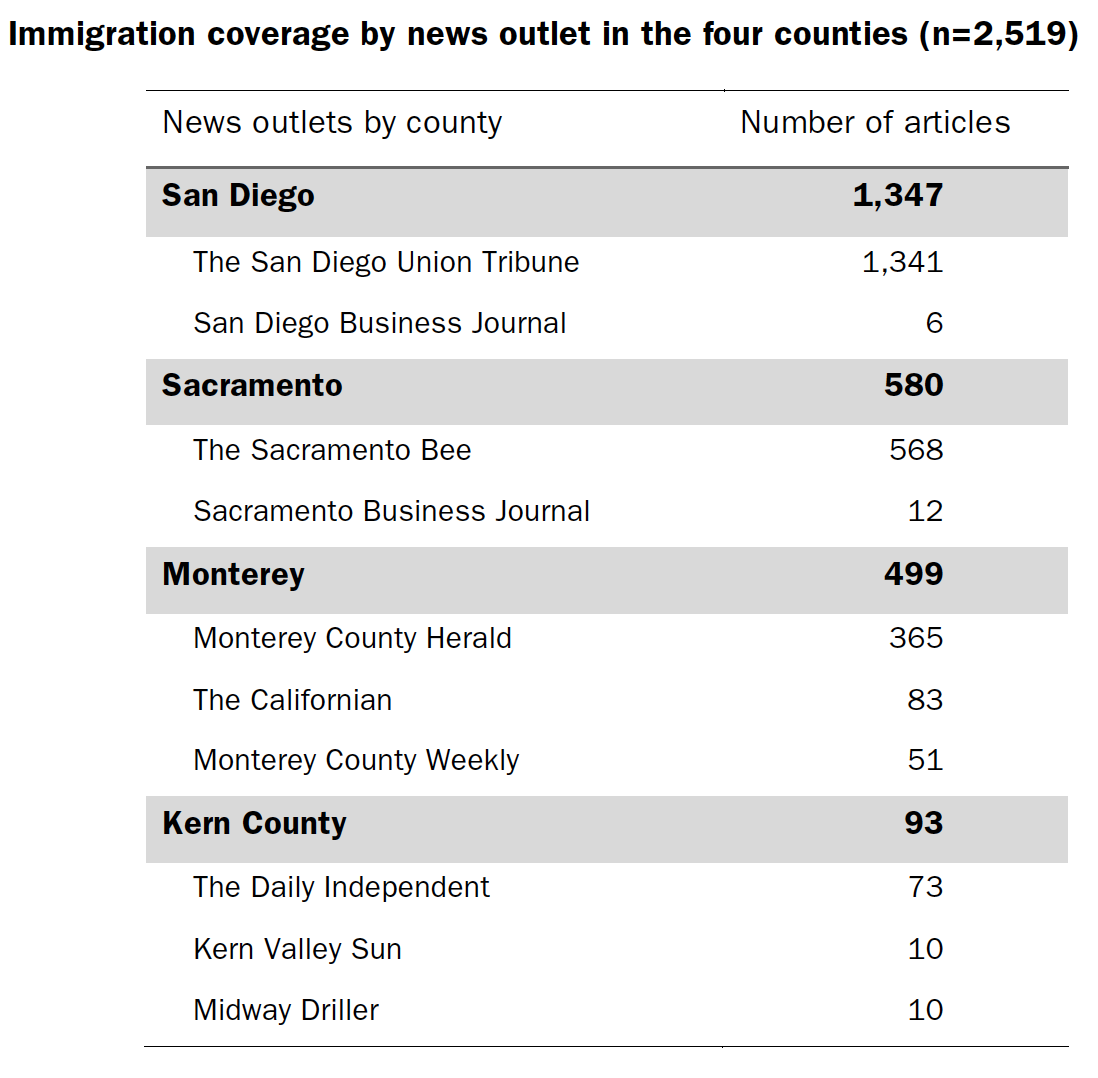Immigration in the news: An analysis of coverage from four California counties
Thursday, February 28, 2019Immigration is a central issue for racial and health equity in California. Community leaders from across the state have expressed their commitment to changing narratives around immigration and immigrant communities as part of their broader advocacy and racial justice work. The hostile political climate facing immigrants in many parts of California means that communicating strategically and centering equity in those narratives is both challenging and urgent. Understanding the current narrative around immigration as it is reflected in news coverage can reveal gaps in the story about immigration and provide direction for strategic communication.
Berkeley Media Studies Group explored how a broad range of immigration issues appear in news coverage from four counties: Monterey, Sacramento, Kern, and San Diego. These counties represent a diverse set of circumstances and regions, including border communities, the Central Valley, and the state Capitol. Advocates working in these locations aim to build public awareness of the social and environmental dimensions of health — including health and racial equity — to mobilize advocacy for structural and policy changes in their counties.
In this report, we summarize our analysis and provide an overview of how immigration is being framed by local media in the four counties, including the challenges, limitations, and opportunities the portrayals present for changing the narrative.
What we did
We searched the Lexis-Nexis database for news and opinion articles discussing immigration published between September 1, 2017 and August 31, 2018 in newspapers representing media markets from the four counties. We analyzed the topics in the coverage and the language used. We also hand-coded a sample of articles to identify who was quoted in the news about immigration and whether the voices and perspectives of immigrants appeared.
What we found
From September 1, 2017 through August 31, 2018, we found 2,519 articles about immigration published from outlets in the four counties. San Diego County had by far the most news coverage about immigration (1,347 articles), with The San Diego Union-Tribune, the main newspaper for the region, covering the issue extensively. Sacramento County (580 articles) and Monterey County (499 articles) also had substantial coverage, while news coverage in Kern County was less frequent (93 articles).
Federal immigration issues dominated California coverage.
The news narrative about immigration was largely driven by policy actions and communication at the federal level, with more than two-thirds of articles referencing President Trump or his administration.

* Articles could include more than one topic.
Of the Trump administration policies discussed, there was substantial coverage of disputes over the Deferred Action for Childhood Arrivals program, or DACA (20% of news articles), the proposed "border wall" (15%), and the Trump administration's zero-tolerance policy and ensuing family separation crisis at the U.S.-Mexico border (13% of articles). There was also some coverage of the Trump administration's so-called "travel ban" or "Muslim ban" (3% of articles) and its moves to restrict the Temporary Protected Status program (1%).
State and local sanctuary policies garnered substantial coverage.
News from the four counties sometimes discussed California- and county-specific immigration issues, although these were largely in reaction to federal policies. In the fall of 2017, for example, state lawmakers passed Senate Bill 54, which turned California into a sanctuary state to counter expanded deportation orders from the Trump administration. Coverage of the bill accounted for nearly a quarter of news articles about immigration in Sacramento County, home to the state Capitol. Overall, coverage of state and local sanctuary policies accounted for 17% of news articles across the four counties.
In San Diego County in particular, immigration coverage often focused on border-specific issues. Over half of the news coverage in San Diego discussed the U.S.-Mexico border in some way (52%), including, for example, stories about Border Patrol arrests in the area.
Public health was not part of the news narrative.
Though there is increasing concern about the public health impact of immigration policies, health was largely invisible in news coverage of immigration. Efforts by the California legislature to expand Medi-Cal to cover undocumented immigrants received little news attention (<1% of articles). Similarly, the Trump administration's proposed changes to the "public charge" rule, which aims to penalize legal immigrants for using benefits such as food stamps or Medicaid (<1%), were largely absent from the coverage. In fact, the term "public health" never appeared in the coverage.
Stigmatizing language about immigrants sometimes appeared.
In recent years, activists have called on news outlets to stop using terms like "illegal" and "aliens" to refer to immigrants without documentation. For example, the "Drop the I-Word" campaign from Race Forward argues that such terms are dehumanizing, racially charged, and legally inaccurate.1 In response to this activism, some news outlets, including The Associated Press, The New York Times, and NPR, have adopted guidelines that discourage the use of these terms and instead recommend more neutral, less discriminatory language.2

*Other terms were "illegal border crossers," "illegal criminals," and "illegal foreign nationals."
We found that while neutral descriptors such as "undocumented" or "unauthorized" were most commonly used in coverage, problematic and potentially dehumanizing terms such as "illegal immigrants," "illegal aliens," or even "illegals" were present in nearly every news outlet we studied, appearing in 13% of all articles. Typically, this language appeared in quotes from Trump administration officials, members of Congress, or anti-immigration activists, or was used in letters to the editor. These statements and letters often described immigrants as dangerous, or as taking jobs, tax dollars, and other resources from non-immigrants (See Table 1).
Who spoke in the news about immigration?
To understand whose perspectives are elevated in the news (and whose are obscured), we analyzed a representative sample of articles (see Appendix) to see which speakers were quoted in the news about immigration.

Government officials dominated the news about immigration.
Government representatives — including state, federal, and local officials — dominated immigration coverage, appearing as speakers in 65% of articles that discussed immigration. Criminal justice representatives — such as police officers, Immigration and Customs Enforcement (ICE) officials, and Border Patrol agents — were also quoted fairly often (26% of articles), as were advocacy group members and other activists (21% of articles).
Undocumented immigrants often spoke about inhumane treatment in immigration enforcement.
Immigrants were rarely quoted in the coverage, appearing in fewer than one in five articles about immigration (14%). When they appeared, undocumented immigrants (6% of articles) were most often quoted to provide emotionally charged first-person accounts of inhumane treatment in detention or at the border. One father recounted: "Being separated from my daughter and my wife was the most painful thing of my life. I felt powerless. … They treated us like criminals."9
Undocumented immigrants also described their fears of deportation and the impact of this uncertainty on their lives. In a rare reference to the health impact of immigration policies, one woman said she would not re-enroll her children in the Children's Health Insurance Program out of concern that her undocumented husband would be deported: "'We're afraid of maybe getting sick or getting into an accident, but the fear of my husband being deported is bigger,' the woman, who declined to give their names for fear her husband could be deported, told The Associated Press through a translator in a telephone interview."10
DACA recipients spoke about their uncertain futures and advocated for their rights.
DACA recipients were quoted in only a fraction of articles about the DACA program — 20% of all articles in our analysis mentioned DACA, but only 3% of articles in our representative sample quoted DACA recipients. When they were quoted, DACA recipients spoke about their uncertainty and anxiety about the future, as when one California State University, Sacramento student said she "was given wings" by the program. She added that if the program ends, "I don't know what's going to become of my life."11
However, DACA recipients also spoke about their experiences of empowerment and activism, even in the face of shifting federal immigration policies. For instance, one DACA recipient who works as a human resources professional for a San Diego nonprofit decided to speak up after former Attorney General Jeff Sessions announced that DACA would end in September 2017: "DACA has helped me realize my full potential here in the country I call home. I used to be in the shadows, and I refuse to go back into the shadows."12
Documented immigrants were rarely quoted on contentious immigration issues.
Documented immigrants were also rarely quoted (3% of articles). When they did appear in the news, they were not usually discussing high-profile immigration issues. Rather, they provided insight on different aspects of the immigrant experience, such as the naturalization process and being in the U.S. workforce. One article, which reported on the first Latina and immigrant woman to be president of a union, quoted Teresa Romero, originally from Mexico, about her new role: "I understand what workers are going through," she said. "I understand how difficult it is. I understand that they don't speak the language. I know how it affects our everyday life."13
Conclusion
During the time period we studied, the news about immigration in Kern, Monterey, Sacramento, and San Diego counties was largely driven by the actions of the Trump administration, while local issues and initiatives received relatively little attention. Derogatory descriptions of immigrants appeared with some regularity, while immigrant voices were rarely included.
To build a stronger narrative about immigration in California that supports health and racial equity, advocates can:
- Strategically respond to news about federal actions. Federal immigration policy issues can change rapidly, and it's important for advocates to be aware of and responsive to the shifting landscape, which may change day by day. To do this, advocates need to monitor the news. When a national story breaks, they can use op-eds or letters to the editor to highlight its local consequences.14 They can also build relationships with local reporters and connect them with sources in the community who can help reframe the debate and provide important context.
- Generate news coverage that combats false narratives about immigrants. In addition to responding to and reframing breaking national stories, advocates should proactively expand the range of local news coverage about immigration. To do that, they need to create news about other aspects of the issue. Advocates can create community events, introduce policy, release studies, give awards, and find other newsworthy ways to highlight the experiences of immigrants and evoke shared values like compassion and community.
- Bring health into the narrative. Immigration policy decisions have far-reaching consequences for physical and mental health. However, news coverage rarely discussed the health and social impact of immigration policies. Advocates can help bring health into the conversation about immigration by talking about how these policies affect access to health care, nutrition, education, protections for victims of sexual or domestic violence, and other public health issues. In addition to providing information about specific policies' impact on public health, advocates, clinicians, and public health practitioners can discuss how these policies contradict the values and ethics they stand for as medical providers.15
- Train spokespeople who can expand the conversation. Currently, government officials and criminal justice representatives dominate the news narrative about immigration. While their perspective is important, other voices are missing. Immigrants in particular were rarely quoted in the coverage. Advocates can help to expand the range of perspectives in news coverage by training immigrants in their local communities to become spokespeople. These spokespeople are the authentic voices who can speak confidently and strategically about their experiences, knowledge, and values. They are also able to illustrate the health and social consequences of our immigration policies. People who have a lot to contribute to this conversation may just need practice to be able to become comfortable being sources for reporters and/or may need introductions to reporters. Advocates can also help negotiate with reporters to keep sources' identities confidential when that may interfere with people's willingness to speak.
- Have conversations with local reporters and editors about the language used to describe immigrants. Problematic terms such as "aliens" or "illegals" most often came from quotes or letter writers, but some news outlets have created guidelines to avoid repeating this type of pejorative language.16,17 For example, when a government official's statement includes terms like "illegal immigrants" or "illegal aliens," NPR's guidelines encourage journalists to paraphrase the statement using neutral language, rather than repeating the problematic terms by using a direct quote.17 Advocates can ask news outlets about their guidelines for talking about immigrants and encourage them to adopt policies that limit the use of derogatory, dehumanizing language.
Appendix: Methodology and sampling
Between September 1, 2017 and August 31, 2018, we found 2,519 articles about immigration in 10 newspapers in Kern, Monterey, Sacramento, and San Diego counties:

In order to conduct an in-depth analysis of who spoke in the coverage, we also selected a representative sample from each county. We took 10% samples of all coverage from San Diego, Sacramento, and Monterey counties. Kern County had far fewer articles, so we took a one-third sample to have a robust set of articles to analyze. Before analyzing the sample, we read each article in the sample and removed irrelevant stories as well as those that mentioned immigration only in passing (e.g., within a list of different issues), resulting in a total of 218 articles.
References
*News of Trump's proposal broke near the end of the timeframe we studied.
1. Drop the I-Word. Race Forward. https://www.raceforward.org/practice/tools/drop-i-word. Accessed January 16, 2019.
2. Ackerman EF. The rise of the "illegal alien." Contexts. 2013;12(3):72-74. doi:10.1177/1536504213499883
3. Navarrette R. Not all Dreamers should be granted legal status. The San Diego Union-Tribune. January 27, 2018.
4. Morrissey K. Noncriminal arrests at local ICE office most in the U.S. The San Diego Union-Tribune. March 11, 2018.
5. Miroff N. Efficacy of U.S. border barriers questioned. The San Diego Union-Tribune. March 13, 2018.
6. Debonis M. Republicans pass measure lauding ICE. The San Diego Union-Tribune. July 19, 2018.
7. Whalley S. Cover the impacts of illegal immigration. The San Diego Union-Tribune. May 10, 2018.
8. J. Harry Jones. Escondido again to focus on immigration law. The San Diego Union-Tribune. April 4, 2018.
9. Morrissey K. Three caravan fathers reunite with families after deadline. The San Diego Union-Tribune. August 16, 2018.
10. Kennedy K. Deportation fears have legal immigrants avoiding health care. AP NEWS. January 21, 2018.
11. Thomson D. California challenges end of DACA program. Monterey County Weekly. September 12, 2017.
12. Morrissey K. Trump administration ends DACA, San Diego dreamers vow to fight. The San Diego Union-Tribune. September 5, 2017.
13. Plevin R. An immigrant woman takes the lead of United Farm Workers after former president steps down. The Californian. August 31, 2018.
14. Tips for writing effective letters to the editor. Berkeley Media Studies Group. http://www.bmsg.org/resources/publications/tips-for-writing-effective-letters-to-the-editor/. Accessed January 23, 2019.
15. Guide for public health actions for immigrant rights. Public Health Awakened. https://publichealthawakened.com/guide-for-public-health-to-protect-immigrant-rights/. Accessed January 23, 2019.
16. Edgar D. L.A. Times updates guidelines for covering immigration. Los Angeles Times. May 1, 2013.
17. New guidance on immigration | NPR Ethics Handbook. http://ethics.npr.org/memos-from-memmott/new-guidance-on-immigration/. Accessed January 11, 2019.
Acknowledgments
This report was written by Laura Nixon, MPH; Sarah Han, BA; Daphne Marvel, BA; Pamela Mejia, MS, MPH; Lori Dorfman, DrPH.
Thanks to Katherine Schaff and Heather Gehlert for their feedback.
This report was made possible by funding from The California Endowment. We thank Judi Larson and all the participants at the Spread and Scale initiative convenings — their valuable insights shaped this work.




